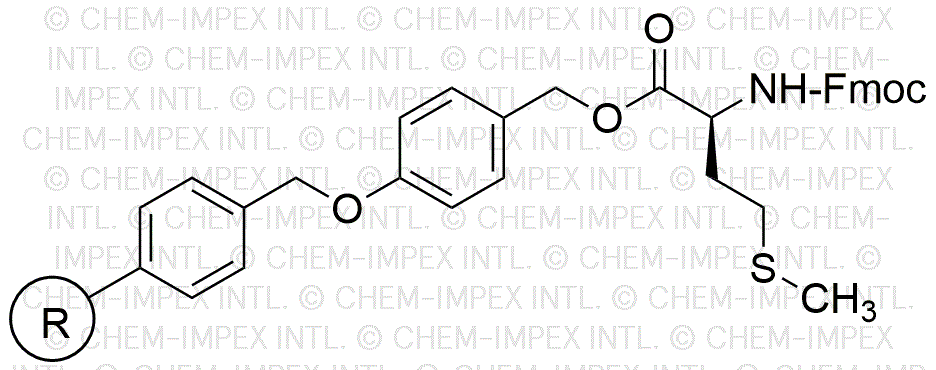Fmoc-L-methionine 4-alkoxybenzyl alcohol is widely utilized in research focused on:
- Peptide Synthesis: This compound serves as a key building block in the synthesis of peptides, facilitating the formation of complex structures that are essential in drug development and biochemical research.
- Drug Discovery: Its unique properties allow researchers to modify peptide sequences, making it valuable in the design of novel therapeutics targeting specific diseases.
- Bioconjugation: The compound can be used to attach biomolecules to surfaces or other molecules, enhancing the efficacy of drug delivery systems and improving the targeting of therapies.
- Research in Cancer Therapeutics: By incorporating this chemical into peptide-based drugs, researchers are exploring new avenues for cancer treatment, potentially leading to more effective therapies with fewer side effects.
- Material Science: Its application extends to the development of functional materials, where it can be used to create polymers with specific properties for use in various industrial applications.
Información general
Propiedades
Seguridad y normativas
Aplicaciones
Fmoc-L-methionine 4-alkoxybenzyl alcohol is widely utilized in research focused on:
- Peptide Synthesis: This compound serves as a key building block in the synthesis of peptides, facilitating the formation of complex structures that are essential in drug development and biochemical research.
- Drug Discovery: Its unique properties allow researchers to modify peptide sequences, making it valuable in the design of novel therapeutics targeting specific diseases.
- Bioconjugation: The compound can be used to attach biomolecules to surfaces or other molecules, enhancing the efficacy of drug delivery systems and improving the targeting of therapies.
- Research in Cancer Therapeutics: By incorporating this chemical into peptide-based drugs, researchers are exploring new avenues for cancer treatment, potentially leading to more effective therapies with fewer side effects.
- Material Science: Its application extends to the development of functional materials, where it can be used to create polymers with specific properties for use in various industrial applications.
Documentos
Hojas de datos de seguridad (HDS)
La SDS proporciona información de seguridad completa sobre la manipulación, el almacenamiento y la eliminación del producto.
Especificación del producto (PS)
La PS proporciona un desglose completo de las propiedades del producto, incluida la composición química, el estado físico, la pureza y los requisitos de almacenamiento. También detalla los rangos de calidad aceptables y las aplicaciones previstas del producto.
Certificados de análisis (COA)
Busque certificados de análisis (COA) ingresando el número de lote del producto. Los números de lote y de partida se pueden encontrar en la etiqueta de un producto después de las palabras "Lote" o "Lote".
Número de catálogo
Número de lote/lote
Certificados de origen (COO)
Este certificado de origen confirma el país en el que se fabricó el producto y también detalla los materiales y componentes utilizados en él y si se deriva de fuentes naturales, sintéticas u otras fuentes específicas. Este certificado puede ser necesario para cumplir con las normativas aduaneras, comerciales y regulatorias.
Número de catálogo
Número de lote/lote
Hojas de datos de seguridad (HDS)
La SDS proporciona información de seguridad completa sobre la manipulación, el almacenamiento y la eliminación del producto.
DownloadEspecificación del producto (PS)
La PS proporciona un desglose completo de las propiedades del producto, incluida la composición química, el estado físico, la pureza y los requisitos de almacenamiento. También detalla los rangos de calidad aceptables y las aplicaciones previstas del producto.
DownloadCertificados de análisis (COA)
Busque certificados de análisis (COA) ingresando el número de lote del producto. Los números de lote y de partida se pueden encontrar en la etiqueta de un producto después de las palabras "Lote" o "Lote".
Número de catálogo
Número de lote/lote
Certificados de origen (COO)
Este certificado de origen confirma el país en el que se fabricó el producto y también detalla los materiales y componentes utilizados en él y si se deriva de fuentes naturales, sintéticas u otras fuentes específicas. Este certificado puede ser necesario para cumplir con las normativas aduaneras, comerciales y regulatorias.

